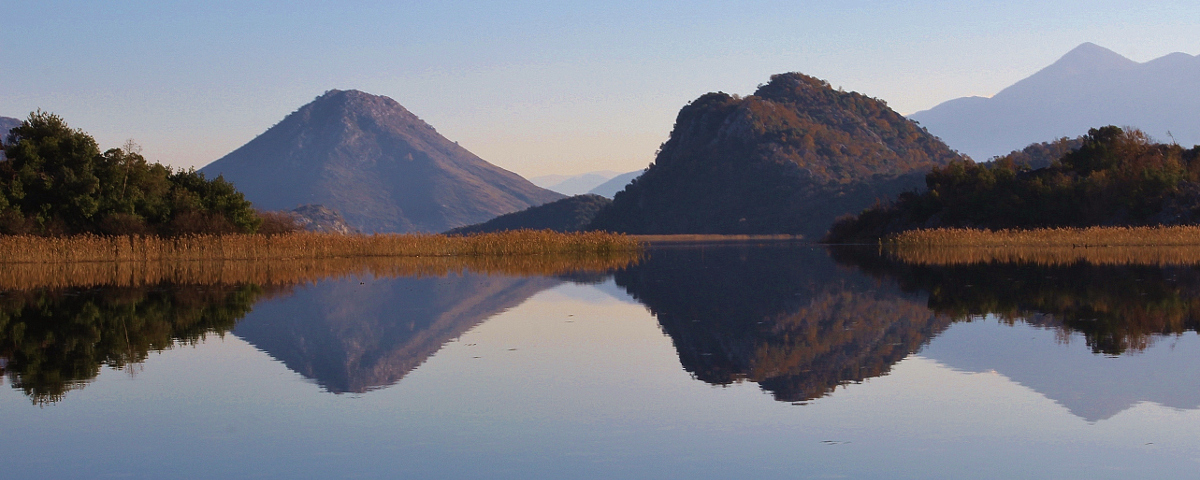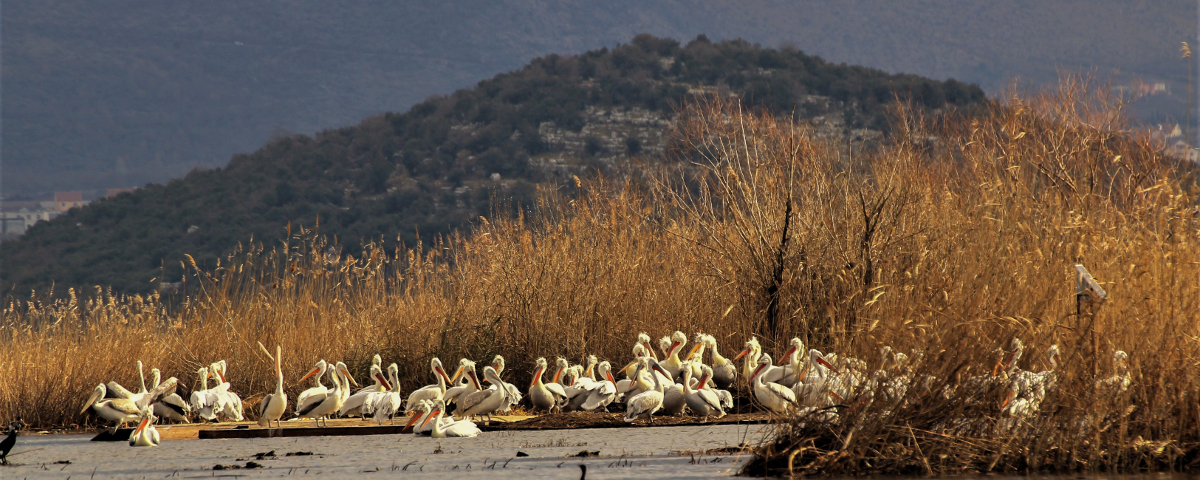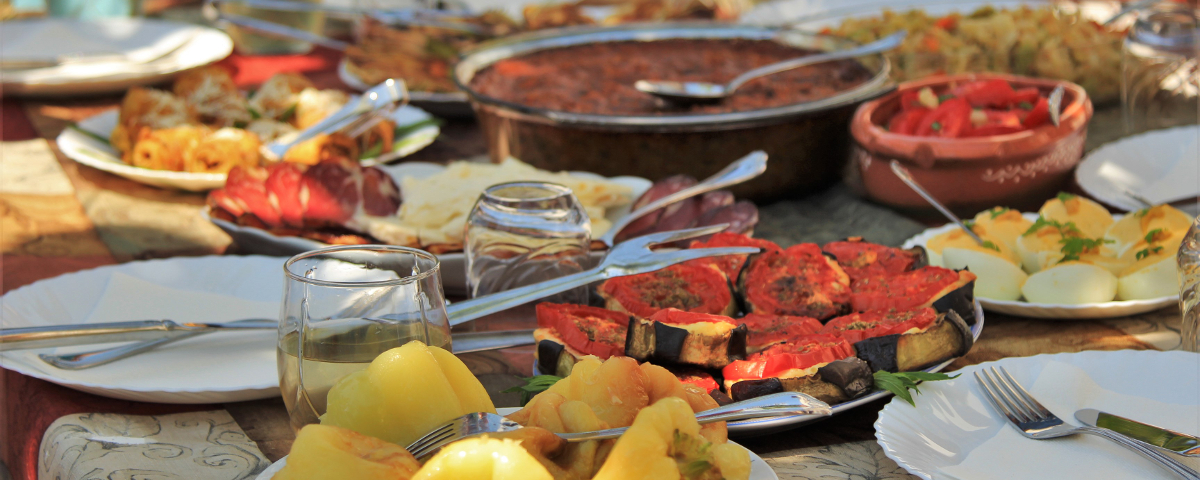Lake Skadar
Lake Skadar is a wild wonder waiting to be explored. A vast freshwater lake straddling the borders of Montenegro and Albania and surrounded by dramatic karst mountains, its mirrored waters, rocky shores and wetlands play host to a myriad of wildlife with more than 260 species of birds, traditional fishing villages, island monasteries and pristine beaches.
Home to some of the most celebrated panoramas in a country renowned for its wild, natural beauty, Lake Skadar has been a protected National Park since 1983 and was added, in 1996, to the World’s List of Wetlands of International Importance by the Ramsar Convention. Many Montenegrins regard this area as their country’s heart and soul. It was here that the former Montenegrin royal family chose to summer, where Turkish invaders sought to conquer, and where some of the best wines and organic food in Montenegro can be found, cultivated by the local producers of Crmnica and Godinje valleys. Scroll on down for more detailed information!
History
 Lake Skadar boasts a rich and proud history. Part of the ancient Slav kingdom of Zeta, the region became a battleground for five centuries after the Turks invaded in the 13th century.
Lake Skadar boasts a rich and proud history. Part of the ancient Slav kingdom of Zeta, the region became a battleground for five centuries after the Turks invaded in the 13th century.
As the Ottoman Empire collapsed, the Turks were expelled and the 1875 Congress of Berlin confirmed the borders of independent Montenegro. Skadar town itself (once the capital of Zeta) was incorporated into Albania while several Albanian villages on the southern shores such as Ostros and Donji-Murici became part of Montenegro. To this day these villages retain a strong Albanian character with mosques and residents bilingual in Albanian and Serbian.
While the Turks conquered the southern shores and the town of Virpazar, placing fortresses at Lessendro, Besac and Grmožur, the north-west wetlands provided a bastion for the Montenegrin rulers. From their ruling seat at Žabljak Crnojevića they launched a series of bloody, retaliatory attacks until they were forced to move their capital to Cetinje in 1482.
Even in the 19th and early 20th century, with the royal seat based in Cetinje, the summer court of King Nikola was set up at the attractive lake town of Rijeka Crnojevića.
In WW2 it was time for Lake Skadar to make history again as Virpazar provided the scene of the first Partisan uprising in Montenegro. A monument in town pays tribute to their bravery.
Geography
 Millions of years ago the sea met the shores of Lake Skadar, as witnessed by the seashell fossils still found scattered about the area. Tectonic plates moved, volcanos flowed and the sea levels subsided, leaving the Zeta-Skadar plain to emerge between the karst (limestone) mountains of the Dinaric Alps range.
Millions of years ago the sea met the shores of Lake Skadar, as witnessed by the seashell fossils still found scattered about the area. Tectonic plates moved, volcanos flowed and the sea levels subsided, leaving the Zeta-Skadar plain to emerge between the karst (limestone) mountains of the Dinaric Alps range.
While legend has it that a young bride, excited by the prospect of her husband’s return, forgot to turn off a fountain tap (overnight producing the lake’s sweet waters), the true story of Lake Skadar’s creation is just as incredible. A violent thunderstorm in 1858 sent the river Drina into a frenzy, creating such a build up at the mouth of the river Bojana that its course was shifted, flooding an existing pool and producing the largest lake in the Balkans.
Fed by the Morača river and and a series of underwater springs, the lake’s circumference expands from 370 square kilometres in summer to a massive 530 square kilometres in winter.
On average it is 44km long, 10km wide and 8 metres deep, although its deepest point, a spring at Raduš, is a crypto-depression (below sea level) at more than 60 metres depth.
Wildlife
 From lush swamp vegetation to ancient chesnuts forests and rocky islets covered with shrubs and pomegranates, the variety of habitats offered by Lake Skadar attract a range of wildlife almost without equal in Europe.
From lush swamp vegetation to ancient chesnuts forests and rocky islets covered with shrubs and pomegranates, the variety of habitats offered by Lake Skadar attract a range of wildlife almost without equal in Europe.
A birders’ paradise, with more than 260 different species including the rare Dalmatian Pelican and Pygmy Cormorant, you will find storks, herons, egrets and ibises perched on reeds while falcons and eagles scour the rocky shores for a tasty snack.
It’s not just about the birds, however. The mountains are home to an abundance of wild tortoises, brilliantly coloured lizards and amphibians and even snakes (don’t worry, we know which ones to look out for!). If you’re lucky, you may even catch sight of wild boar and even a wolf or two in winter.
Every path and pasture is full of the medicinal herbs for which the area is famous, and wild orchids grow among them. In summer, water lilies line the surface of the lake. In winter, as the lake swells by over 100 square kilometres, pike, perch, trout and carp join the estimated 50,000 birds wintering in the region.
Gastronomy
 For the globe-trotting gourmet, Lake Skadar can offer several gastronomic delights. Straddling the borders of Albanian and Montenegrin cuisines and sitting in an ideal climate between the mountains and the sea, it is little wonder that conditions around the lake are ideal for all manner of organically produced treats. Every valley is a delight for the senses, the air filled with the scent of wild sage, rosemary and mint. Mandarins, plums, cherries, figs, walnuts, peppers and pomegranates can be found in almost every garden and on every hiking trail, along with locally produced goat’s cheese, delicious domestic honey, home-distilled rakija and several flavours of home-cured pršut (smoked ham).
For the globe-trotting gourmet, Lake Skadar can offer several gastronomic delights. Straddling the borders of Albanian and Montenegrin cuisines and sitting in an ideal climate between the mountains and the sea, it is little wonder that conditions around the lake are ideal for all manner of organically produced treats. Every valley is a delight for the senses, the air filled with the scent of wild sage, rosemary and mint. Mandarins, plums, cherries, figs, walnuts, peppers and pomegranates can be found in almost every garden and on every hiking trail, along with locally produced goat’s cheese, delicious domestic honey, home-distilled rakija and several flavours of home-cured pršut (smoked ham).
The lake’s waters are home to over 30 species of fresh-water fish, among them succulent trout, meaty saran and the local speciality, carp, all of which can be caught, bought, cooked and eaten the very same day. We will share the secrets with you of the very best local restaurants. Hint: they’re not the sort that advertise!
Best of all are the renowned wines of the Zeta plains and Crmnica Valley. The red vranac and white krstač grapes are not just famous throughout the former Yugoslav republics – the wines they produce are international award-winners in their own right. The nearby Plantaže vineyard is one of the largest in the whole world, whilst the smoothest gold medalists are to be found in Crmnica, where a handful of local vintners maintain a proud tradition of wine-growing excellence.
Whether you’re hiking, biking, kayaking or just relaxing on one of our Lake Skadar adventures, you’re never far away from the best organic produce Montenegro has to offer.



